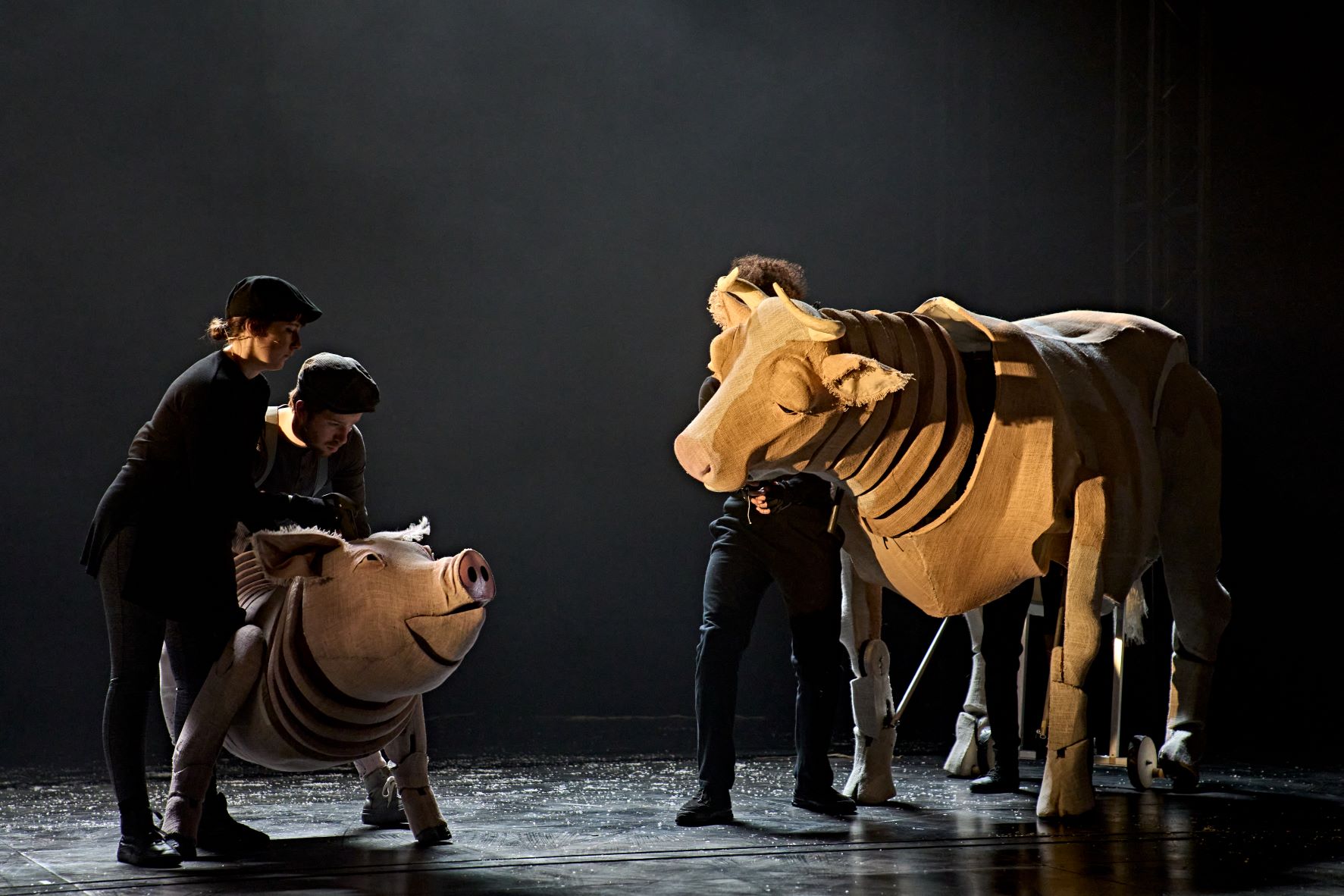
Deputy Editor Jasmine Sandhar praises The Rep’s production of Animal Farm for its skilful use of puppetry and the continued relevance of its material
Despite its historical retelling of the events that constituted the Russian Revolution, Animal Farm (1945) is a novel that I have always considered to be ahead of its time. George Orwell’s genius utilisation of animalistic allegory – with greedy pigs representing the unscrupulous nature of key Bolshevik leaders and noble horses embodying the loyal spirit of the ordinary proletariat – was groundbreaking in its ability ‘to fuse political purpose and artistic purpose into one whole.’ After having the pleasure of watching The Children’s Theatre Partnership’s theatrical production of this classic text at the legendary Birmingham Rep, I can unequivocally confirm that award-winning writer and theatre director Robert Icke has maintained the enduring legacy of Animal Farm.
“The principal challenge of this show is figuring out how to get human actors to play animals effectively
The principal challenge of this show is figuring out how to get human actors to play animals effectively. In previous versions, there has been more of a singular focus that is either concerned with the life-like intricacies of costume – for example in 2018 with the Soulpepper Theatre Company – or on the more abstract expression of physicality and body language – as most recently seen last year with the National Youth Theatre. Icke defied this traditional categorisation, finding a way to synthesise both aspects through the art of puppetry.
As puppeteering is conventionally associated with dolls on strings and a target audience of children who will laugh at anything, I was unsure of what to envision at first. In truth, it was hard not to imagine some skewed rendition of Punch and Judy. However, rather thankfully, my expectations were completely incorrect. Designed by artistic mastermind Toby Olié, these puppets were life-size and looked uncannily realistic. Everything had been thought out from the smaller details of the feathering on the birds to the huge task of devising a six-foot-tall Boxer. My favourite interpretation was that of the sheepdog Bluebell, whose shaggy coat was comprised of thousands of angled tissue paper ruffles that effortlessly bobbed up and down as he ran around.
“The puppeteers did an incredible job of nailing the physicality of the animals
Indeed, the movement of the puppets was just as important as their aesthetic appearance. All of the puppeteers did an incredible job of nailing the physicality of the animals, mimicking the flight of Moses the raven with expert fluidity and capturing the nonchalance of the anonymous cat grooming itself. The puppeteering reached peak performance during the scenes of hardship when Boxer, Clover and Muriel were building the windmill, as the reflexes of the animals battling against the windy weather conditions looked extremely natural. This was partially aided by the flexibility of the elastic coils on the joints of the animals, but the conscious and exhausting effort that the puppeteers put in for every single minute of the production really did pay off. With the addition of the onomatopoeic noises of oinking pigs, honking geese and bleating sheep to these bodily gesticulations, at times it became impossible to tell whether I was watching actual animals or not.
This simulation concept was developed further by Icke’s applications of cinematic techniques to the play. By having varying sizes of the puppets, the cast was able to implement a zoom-in and zoom-out effect that mirrored the effect of a cameraman alternating between different lenses. Furthermore, slow-motion was employed at several points to capture the dramatic scenes typically seen in action films. The configuration of the set design was meticulous, as the vertically wood-panelled barn doors were capable of sliding across the stage so that the separate shots were connected through smooth transitions that looked like they had been edited in a film’s post-production. Nevertheless, there was also the option of keeping scenes choppy, as a digital screen was attached to the top of the stage which displayed temporal phrases (such as ‘one week later’) to jump around the plotline appropriately. Additionally, the pulsating music and lighting were manipulated in such a way that the hundred-year-old building came to somehow resemble a hi-tech Hollywood movie studio. These cinematic qualities provided the reality needed to do justice to the tragic political satire.
“There were split-seconds of humour that punched holes of light into the darkness
However, this looming shadow did not overwhelm the entire evening, for there were split-seconds of humour that punched holes of light into the darkness. The sheep, who were the most illiterate animals on the farm, garnered fits of laughter with their constant chants of ‘four legs good, two legs bad.’ Another standout moment was when Muriel the goat decisively headbutted an already defeated farmer in his nether regions, causing him to flee for good. My personal favourite comedic episodes were the exchanges between the gossiping chickens, especially given Barbara’s selective hearing. There was even a lightheartedness in the unfortunate mishaps, such as the fallen pigtail of Snowball that remained centre-stage for a good few scenes before being discreetly removed, or when Napoleon pre-empted a cue and his mouth was comically moving with no speech.
All in all, Animal Farm was a revolutionary experience. I have not seen a performance as daring or innovative at the Rep prior to this one and it has definitely set the bar for the acts that are to follow. Icke has managed to capture the essence of what Orwell created, whilst simultaneously modernising the message so that it remains relevant today. Undeniably, this is exactly what Orwell wanted – in a letter about his novel he writes, ‘Of course I intended it primarily as a satire on the Russian revolution. But I did mean it to have a wider application in so much that I meant that kind of revolution […] can only lead to a change of masters.’ So, what happens when we apply Animal Farm to today? Arguably, it still stands up tall.
“All animals are equal, but some animals are more equal than others
In particular, there is the way that the Seven Commandments of Animal Farm were continually altered to represent the exact opposite of what they were supposed to. This is epitomised by the final maxim Squealer declares towards the end of the play: ‘All animals are equal, but some animals are more equal than others.’ Animal Farm, regardless of its form as a book or theatre performance, highlights the pervasive nature of corrupt politics throughout history.
Animal Farm plays at the Birmingham Repertory Theatre until 5th February 2022.
Enjoyed This? Read more from Redbrick here!
George Orwell: Political Writing As An Art
Lessons Learned To Date: The Government Should Be Facing More Repercussions

Comments